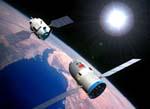 |
"Shenzhou II" Spacecraft Returns

"Shenzhou II" Spacecraft Returns
Shenzhou-II, China's second unmanned space shuttle launched on January 10 touched down smoothly in the central part of the Inner Mongolia Autonomous Region in north China Tuesday at 19:22 (Beijing Time), after flying 108 circles around the earth in nearly one week.
The successful recovery of the space vessel serves as a special gift to Chinese people, who are slated to mark the lunar Spring Festival, which is just seven days away.
``Shenzhou unmanned space capsule made a nearly 7-day, 108-orbit voyage after being blasted off from Jiuquan Satellite Launch Centre on January 10," said a spokesman at the Beijing Aerospace Command and Control Centre.
It soft-landed in central Inner Mongolia at 7:22 pm, after completing the planned space science and technical experiments, he said.

"Shenzhou II" Spacecraft Returns
Shenzhou II was composed of an orbital module, returning module and booster rockets, almost identical to how a manned spacecraft would be constructed, according to the centre sources.
During the past few days, the centre had directed the tracking networks on land and at sea to track and monitor Shenzhou II, and sent a series of directions and data to the spacecraft and made it complete hundreds of sophisticated actions.
At 6:33 pm Tuesday, when Shenzhou II was flying over the Atlantic, Yuanwang, a tracking vessel in the ocean, signalled the spacecraft to travel back to earth, according to the spokesman.
Before that, the Beijing centre had directed Shenzhou II from its initial oval orbit into a round one, and ignited the spacecraft's engine for the second time to maintain a good condition of the flying orbit.

China's Second Spacecraft Returns
Upon receiving the tele-commands from the Yuanwang vessel, the returning module of Shenzhou II detached itself from the orbital module, and flew towards its preset destination in a grassland in central Inner Mongolia.
The Xi'an Satellite Tracking and Controlling Centre soon discovered the capsule, according to the spokesman.
The returning module will be sent to Beijing within a few days, so that scientists there could conduct analysis and research on the capsule and the experimental items in it.
In fact, during its week-long flight, experiments on space life environment, space materials, space astronomy and physics, and voice transmission had been conducted on the spacecraft.
Space watchers noted that Tuesday's uncrewed test mission was the second in a series expected to lead to a first manned space voyage in the early 21st century.
China conducted its first maiden flight of ``Shenzhou" in November 1999, also at the Jiuquan launch site.
An expert at the China Aerospace Science and Technology Corporation, who declined to be identified, said China needed ``three to four more test flights of unmanned space aircraft" before it can send a human into space.
Luan Enjie, director of the State Aerospace Bureau, further said that the country's first generation of astronauts were ``receiving intensive training."

In This Section

|